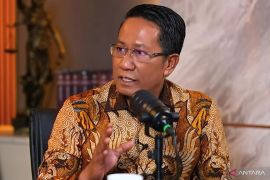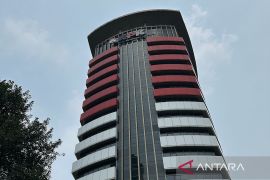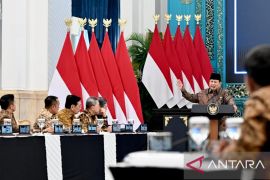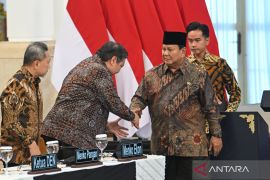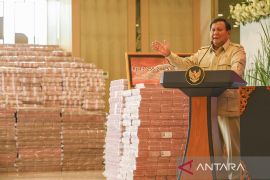Based on this record, cases of corruption in the procurement of goods and services emerged as the second-most frequently prosecuted by the KPK in 2021.
It ranked second after bribery, with 35 cases, which were related to the procurement of goods and services, Head of the Government Goods and Service Procurement Policy Agency (LKPP) Roni Dwi Susanto noted.
He cited as an example a company keen to bag a project, thereby fueling bribery to enter with the government, as the bribe recipient, and the company, as the provider.
The procurement of goods and services plays a huge role in Indonesia's state budget. Some 53 percent of Indonesia's state budget is attributed to the procurement of goods and services, he highlighted.
In 2021, the total contribution of goods and service procurement to the state budget had reached Rp1,200 trillion, Susanto noted.
With this large figure, the procurement of goods and services is deemed to be closely linked to acts of corruption.
KPK's Chief Firli Bahuri also expressed a view that was not too disparate to Susanto's viewpoint.
At a press conference on Thursday, Bahuri noted that acts of corruption in the procurement of goods and services had become a classic method that involved several parties.
In fact, this act of corruption starts from the planning to execution and also the monitoring stages.
The public stands to be impacted the most by such act since corruption in the procurement of goods and services reduces the quality of these goods and services, he pointed out.
KPK's Investigation Director for the September 2020-December 2021 period Setyo Budiyanto noted that corruption in the procurement of goods and services could be detected right from the planning to execution and monitoring stages.
Violation patterns
Budiyanto drew attention to several patterns of violation during the planning or preparation stage for the procurement of goods and services.
The first is the markup pricing for the procurement plan. Secondly, the procurement is directed to cater to the interests of a certain product or goods and services' provider.
The third is unrealistic planning, especially concerning the time frame. The fourth violation pertains to a committee working together behind closed doors with no honesty and may even be controlled by certain parties.
The fifth glitch is that the Self-Estimated Price (HPS) in the procurement of goods and services plan is obscured. The sixth violation concerns the basic price that does not match with the existing standard.
The seventh is that the technical specification refers to a certain product. The eighth violation pertains to the auction document that fails to align with the existing standard. The last violation is in the form of an incomplete auction document.
During the procurement stage, several violation patterns emerge that refer to acts of corruption, which can be seen from 11 aspects, according to Budiyanto.
The first is that the announcement period for the procurement of goods and services process is shortened. Secondly, the announcement is incomplete and confusing. Thirdly, distribution of the tender document appears to be flawed.
The fourth concerns restriction in the dissemination of information by the committee, so that only a certain group could obtain complete details.
In the fifth pattern, the explanation on a project is turned into a question and answer.
Sixth, an effort is made by certain parties to obstruct the entry of a bidding document, so that certain members deliver their documents too late.
In the seventh pattern, document exchange is conducted by slipping in a revision in the initial document.
Moreover, in the eight pattern, the committee worked together behind closed doors, while the ninth involves the announcement of the tender winner to a certain group.
The tenth concerns how not every rebuttal is responded to. Lastly, the issuance of a stipulation letter is intentionally delayed.
Budiyanto also highlighted several violation patterns during the formulation and signing of the goods and service procurement contract.
The first is that the contract signing is not complemented with a supporting document. The second concerns a delay in the contract signing.
Moreover, violation is committed during the contract execution and the provision of goods and services stage, specifically goods and services that do not match with the specification as well as unfinished work, but the handover has been conducted.
During the monitoring stage, collusion between the project operator and its supervisor is also a form of violation. The most obvious sign of violation is bribery extended to the project's supervisor.
Violation also comes in the form of a report from the project's supervisor that does not match with the work's outcome.
In the last stage, during the finance and audit report, the KPK often came across reports that were fraudulent and delivered untrue accounting evidence.
Hence, how should the government, especially the KPK, strive to manage the procurement of goods and services that should become best development products for the people but has instead becomes a fertile group for corruption?
Elimination efforts
The KPK emphasized that prevention, as an initial step, plays an important role in eliminating corruption in the procurement of goods and services.
One of the efforts is a proposal on the need to monitor HPS by the Goods and Services Procurement Work Unit (UKPBJ).
The UKPBJ could be assisted by the Government's Internal Supervisory Apparatuses (APIP) or in cooperation with the Finance and Development Supervisory Agency (BPKP).
Moreover, a probity audit is crucial during the planning, preparation, and execution of the auction all the way up to the post-auction period and the goods and services handover.
Probity audit is an independent evaluation to ensure that the process of procurement of goods and services consistently aligns with the principles of integrity and truth.
This has been stipulated within the scope of applicable laws for increasing accountability in terms of the state finances.
Efforts made entail review of the goods and services procurement planning, so that the planned activities can proceed well and be implemented in accordance with the requirement.
Subsequently, an evaluation and provision of legal assistance are necessitated in the event of a rebuttal, and special audit if a public complaint arises.
In addition, an IT audit should be conducted in the wake of a problem encountered with the information and technology system and procurement of goods and services compliance audit to fix any loopholes in the management of activities.
Digitalization conducted by the LKPP also aims to prevent corruption in the procurement of goods and services through the e-marketplace to fulfill the government's goods and service requirement.
The e-marketplace is expected to minimize mistakes and violation practices in the procurement of goods and services.
Through such efforts, what is no less important is the commitment of the government and all related parties, so that the procurement of goods and services could prioritize honesty.
Hence, this would produce products offering maximum benefits to all Indonesians.
Related news: KPK interrogates 7 witnesses in COVID-19 goods procurement graft case
Related news: State suffers potential loss of Rp2.1 trillion in electronic ID procurement
Related news: KPK questions deputy national police chief as witness
Editor: Rahmad Nasution
Copyright © ANTARA 2022



